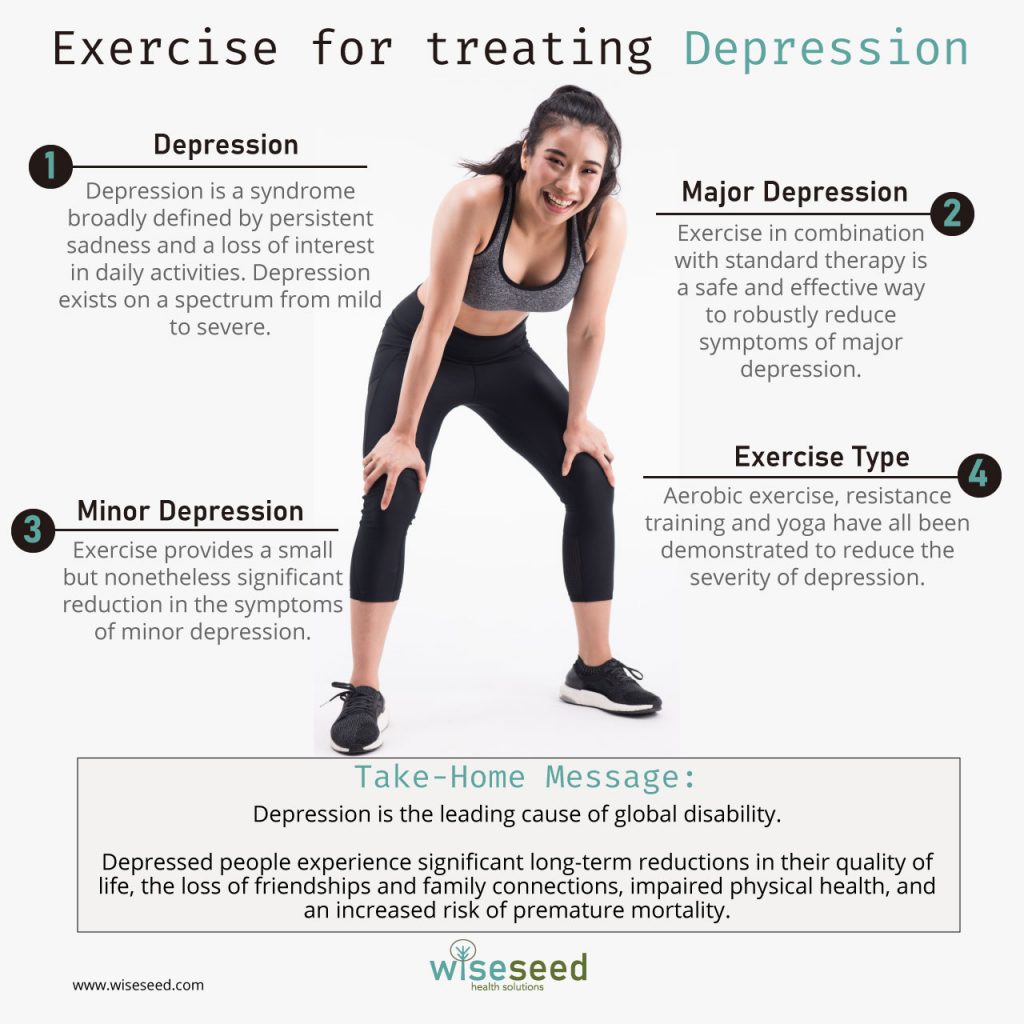Exercise for Treating Depression

“You say you’re ‘depressed’ – all I see is resilience. You are allowed to feel messed up and inside out. It doesn’t mean you’re defective – it just means you’re human.”
― David Mitchell, Cloud Atlas
Just as we are coming out of a global pandemic, we face war, floods, and a looming economic crisis.
During such periods of unrelenting stress, it’s easy to become disheartened and succumb to depression.
Sadly, you can’t influence the weather or change the direction of geopolitics. However, you can do your best to stay strong and support your family, friends, and community during times of strife.
To help you keep going in the face of uncertainty, I briefly review how exercise strengthens your mind by reducing the symptoms of depression.
First, what is depression?
Depression is a syndrome broadly defined by persistent sadness and a loss of interest in daily activities. While people often refer to being either depressed or happy, depression exists on a spectrum from mild to severe.
Major Depression
A diagnosis of major depression can only be made by a health professional using a stringent diagnostic approach (see Table One) (1). The hallmarks of major depression are 1) a depressed mood (i.e., feeling sad, empty, and hopeless); 2) a marked lack of interest in almost all or all daily activities, nearly every day; and 3) the symptoms are chronic (experienced for at least two weeks) (1).
| 1. | Depressed mood most of the day, nearly every day, as indicated by either subjective report (e.g., feels sad, empty, hopeless) or observation made by others (e.g., appears tearful). Note: In children and adolescents, can be irritable mood. |
| 2. | Markedly diminished interest or pleasure in all, or almost all, activities most of the day, nearly every day (as indicated by either subjective account or observation). |
| 3. | Significant weight loss when not dieting or weight gain (e.g., a change of more than 5% of body weight in a month) or decrease or increase in appetite nearly every day. Note: In children, consider failure to make expected weight gains. |
| 4. | Insomnia or hypersomnia nearly every day. |
| 5. | Psychomotor agitation or retardation nearly every day (observable by others, not merely subjective feelings of restlessness or being slowed down). |
| 6. | Fatigue or loss of energy nearly every day. |
| 7. | Feelings of worthlessness or excessive or inappropriate guilt (which may be delusional) nearly every day (not merely self-reproach or guilt about being sick). |
| 8. | Diminished ability to think or concentrate, or indecisiveness, nearly every day (either by subjective account or as observed by others). |
| 9. | Recurrent thoughts of death (not just fear of dying), recurrent suicidal ideation without a specific plan, or a suicide attempt or a specific plan for committing suicide. |
Minor Depression
While people with minor depression often experience significant and often debilitating depressive symptoms, the severity and number of symptoms fall below the threshold required for a diagnosis of clinical depression (2).
The most common symptoms experienced during minor depression are anxiety, tension, irritability, reduced energy, fatigue, sleep disturbances, and an unhealthy focus on physical ailments (3). However, people with minor depression experience a wide variety of debilitating symptoms, as summarized in Table Two (3).
| Category | Symptoms |
|---|---|
| Cognitive | Indecision and impaired concentration Worrying Decreased self-esteem |
| Emotional | Anxiety Irritability Tension Feeling sad, uneasy, or dissatisfied Agitation Inability to feel pleasure Hopelessness |
| Physical | Sleep disturbances Fatigue, tiredness, and lack of energy Appetite (reduced or increased) Pain (head, back, chest, arms/legs, and abdomen) |
| Psychomotor | Restlessness Slowness of movement |
The Cost of Depression
Astonishingly, major depression is the leading cause of global disability (4), with approximately 20% of people experience major depression during their lifetime (5). Most experience significant long-term reductions in their quality of life, loss of friendships and family connections, impaired physical health, and an increased risk of premature mortality (6). Sadly, by 2030, it’s predicted that major depression will become the primary disease burden in developed societies (7).
Unfortunately, minor depression is even more common than major depression (8). Worse, the prevalence of minor depression increases with age (9). Moreover, minor depression increases mortality, reduces the quality of life, increases healthcare service utilization, and imposes significant economic costs (2, 9-11).
Does Exercise Improve Minor Depression?
To answer this question, Bellón and Colleagues analyzed 14 randomized clinical trials to assess the effectiveness of exercise in reducing symptoms of minor depression (12). They found that exercise provides a small but significant reduction in subclinical depression symptoms (12).
The confirmation that exercise alleviates minor depression is an essential finding for three reasons.
First, because minor depression is widespread, reducing the severity of minor depression can potentially improve many people’s lives.
Second, reducing the severity of minor depression may prevent people from progressing to full-blown major depression.
Finally, exercise provides a viable option for those individuals who either dislike or don’t respond to traditional therapies (12).
Thus, exercise has a central role in treating minor depression (12).
Does Exercise Reduce Symptoms of Major Depression?
Lee and Colleagues analyzed 22 clinical trials that compared standard depression therapy alone or in combination with exercise (13).
Strikingly, they found that exercise combined with standard care significantly improves depression compared to standard care alone (13). For patients with moderate depression, exercise provides a moderate (and statistically significant) improvement in depression (13).
Crucially, exercise combined with standard care provides a strong (and statistically significant) improvement for people with severe depression (13)!
Thus, exercise is a highly effective intervention for reducing the severity of major depression.
How Does Exercise Reduce Depression?
While it’s currently unknown how exercise alleviates depressive symptoms, there are at least two reasons that may explain how exercise improves depression (13).
First, inflammation contributes to depression, and exercise reduces inflammation (13). Therefore, it’s plausible that exercise reduces symptoms of depression by decreasing inflammation (13).
A second, more exciting hypothesis involves neuroplasticity.
Anti-depressive drugs that are part of the standard of care for treating depression work by increasing neuroplasticity (13). Exercise elevates hormones that increase neuroplasticity (13). Thus, exercise combined with anti-depression medication may elevate neuroplasticity above each intervention alone (13).
What Type of Exercise is Best?
There are many types of exercise. The question is, which is best for reducing symptoms of depression?
Fortunately, aerobic exercise, resistance training, the combination of aerobic and resistance training, and yoga all reduce depression (12, 13). Therefore, feel free to choose whichever type of exercise you most enjoy.
Take-Home Message
For people suffering from major depression, exercise in combination with standard therapy is a safe and effective way to reduce symptoms of depression.
For those experiencing minor depression, exercise provides a small but nontheless significant reduction in the symptoms of depression.
Aerobic exercise has the most robust clinical support for reducing the severity of depression. However, both resistance training and yoga have also been demonstrated to reduce the severity of depression.
Thus, if you are feeling down, choose the type of exercise you enjoy most, and consider making it a regular part of your life.
Online Resources for Dealing with Depression
Although this article is focused on the use of exercise to assist with depression, exercise is just one of many therapeutic options available to treat depression.
Some excellent online resources to support people with depression within Australia include Beyond Blue, The Black Dog Institute, and The Australian Government.
Crucially, online support for depression can be found in almost every country (e.g., the USA, the UK, and Canada).
Furthermore, your local doctor can direct you to a psychologist or psychiatrist who can provide you with crucial support during dark times. And finally, let’s not forget that friends, family, and colleagues can also provide support during difficult times of life.

Acknowledgements
Images created by xmee and Srdjanns74
References and Further Reading
1. R. W. Lam et al., Canadian Network for Mood and Anxiety Treatments (CANMAT) 2016 Clinical Guidelines for the Management of Adults with Major Depressive Disorder: Section 1. Disease Burden and Principles of Care. Can J Psychiatry 61, 510-523 (2016).
2. P. Cuijpers, R. de Graaf, S. van Dorsselaer, Minor depression: risk profiles, functional disability, health care use and risk of developing major depression. J Affect Disord 79, 71-79 (2004).
3. G. Benasi, G. A. Fava, J. Guidi, Prodromal Symptoms in Depression: A Systematic Review. Psychother Psychosom 90, 365-372 (2021).
4. World Health Organization, “Depression and other common mental disorders: global health estimates,”(World Health Organization, 2017).
5. E. Bromet et al., Cross-national epidemiology of DSM-IV major depressive episode. BMC Med 9, 90 (2011).
6. H. Herrman et al., Time for united action on depression: a Lancet-World Psychiatric Association Commission. Lancet 399, 957-1022 (2022).
7. Q. Liu et al., Changes in the global burden of depression from 1990 to 2017: Findings from the Global Burden of Disease study. J Psychiatr Res 126, 134-140 (2020).
8. P. Rucci et al., Subthreshold psychiatric disorders in primary care: prevalence and associated characteristics. J Affect Disord 76, 171-181 (2003).
9. T. W. Meeks, I. V. Vahia, H. Lavretsky, G. Kulkarni, D. V. Jeste, A tune in “a minor” can “b major”: a review of epidemiology, illness course, and public health implications of subthreshold depression in older adults. J Affect Disord 129, 126-142 (2011).
10. P. Cuijpers et al., Economic costs of minor depression: a population-based study. Acta Psychiatr Scand 115, 229-236 (2007).
11. P. Cuijpers et al., Differential mortality rates in major and subthreshold depression: meta-analysis of studies that measured both. Br J Psychiatry 202, 22-27 (2013).
12. J. Bellón et al., Effectiveness of exercise-based interventions in reducing depressive symptoms in people without clinical depression: systematic review and meta-analysis of randomised controlled trials. Br J Psychiatry 219, 578-587 (2021).
13. J. Lee, M. Gierc, F. Vila-Rodriguez, E. Puterman, G. Faulkner, Efficacy of exercise combined with standard treatment for depression compared to standard treatment alone: A systematic review and meta-analysis of randomized controlled trials. J Affect Disord 295, 1494-1511 (2021).
Disclaimer
The material displayed on this website is provided without any guarantees, conditions or warranties as to its accuracy.
Information written and expressed on this website is for education purposes and interest only. It is not intended to replace advice from your medical or healthcare professional.
You are encouraged to make your own health care choices based on your own research and in conjunction with your qualified practitioner.
The information provided on this website is not intended to provide a diagnosis, treatment or cure for any diseases. You should seek medical attention before undertaking any diet, exercise, other health program or other procedure described on this website.
To the fullest extent permitted by law we hereby expressly exclude all warranties and other terms which might otherwise be implied by statute, common law or the law of equity and must not be liable for any damages whatsoever, including but without limitation to any direct, indirect, special, consequential, punitive or incidental damages, or damages for loss of use, profits, data or other intangibles, damage to goodwill or reputation, injury or death, or the cost of procurement of substitute goods and services, arising out of or related to the use, inability to use, performance or failures of this website or any linked sites and any materials or information posted on those sites, irrespective of whether such damages were foreseeable or arise in contract, tort, equity, restitution, by statute, at common law or otherwise.

Ten Minutes is All You Need
Research has shown that ten minutes of moderate-to-vigorous exercise performed each day is enough to significantly reduce your risk of early death.
- « Previous
- 1
- …
- 31
- 32
- 33



